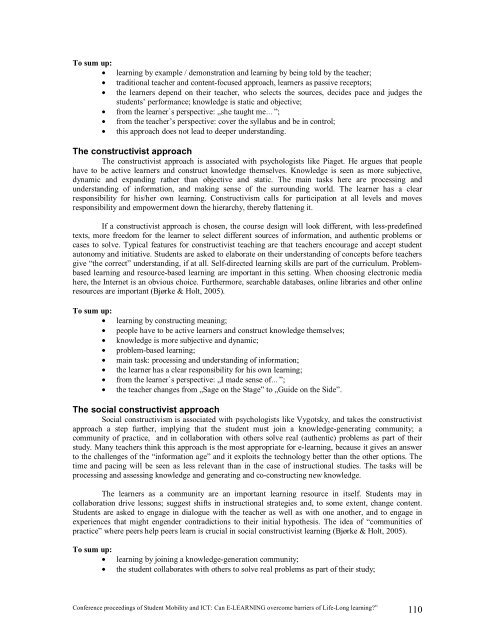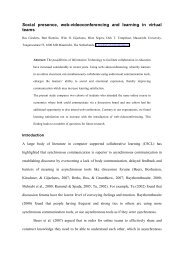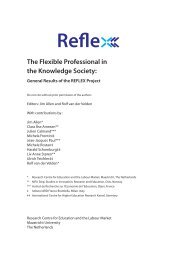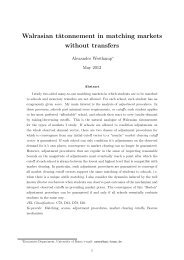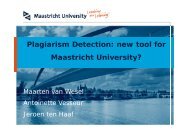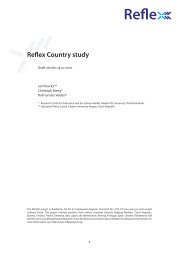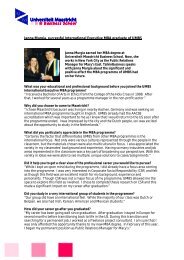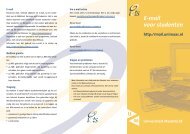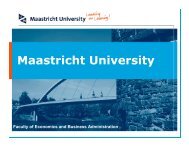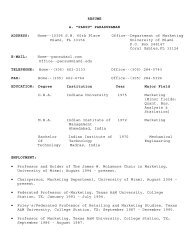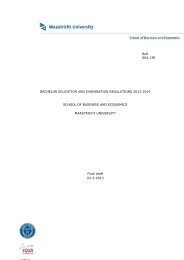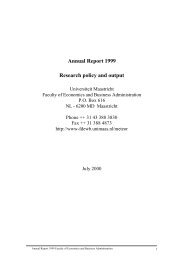proceedings of Student Mobility and ICT: Can E-LEARNING
proceedings of Student Mobility and ICT: Can E-LEARNING
proceedings of Student Mobility and ICT: Can E-LEARNING
You also want an ePaper? Increase the reach of your titles
YUMPU automatically turns print PDFs into web optimized ePapers that Google loves.
To sum up:<br />
• learning by example / demonstration <strong>and</strong> learning by being told by the teacher;<br />
• traditional teacher <strong>and</strong> content-focused approach, learners as passive receptors;<br />
• the learners depend on their teacher, who selects the sources, decides pace <strong>and</strong> judges the<br />
students’ performance; knowledge is static <strong>and</strong> objective;<br />
• from the learner`s perspective: „she taught me… ”;<br />
• from the teacher’s perspective: cover the syllabus <strong>and</strong> be in control;<br />
• this approach does not lead to deeper underst<strong>and</strong>ing.<br />
The constructivist approach<br />
The constructivist approach is associated with psychologists like Piaget. He argues that people<br />
have to be active learners <strong>and</strong> construct knowledge themselves. Knowledge is seen as more subjective,<br />
dynamic <strong>and</strong> exp<strong>and</strong>ing rather than objective <strong>and</strong> static. The main tasks here are processing <strong>and</strong><br />
underst<strong>and</strong>ing <strong>of</strong> information, <strong>and</strong> making sense <strong>of</strong> the surrounding world. The learner has a clear<br />
responsibility for his/her own learning. Constructivism calls for participation at all levels <strong>and</strong> moves<br />
responsibility <strong>and</strong> empowerment down the hierarchy, thereby flattening it.<br />
If a constructivist approach is chosen, the course design will look different, with less-predefined<br />
texts, more freedom for the learner to select different sources <strong>of</strong> information, <strong>and</strong> authentic problems or<br />
cases to solve. Typical features for constructivist teaching are that teachers encourage <strong>and</strong> accept student<br />
autonomy <strong>and</strong> initiative. <strong>Student</strong>s are asked to elaborate on their underst<strong>and</strong>ing <strong>of</strong> concepts before teachers<br />
give “the correct” underst<strong>and</strong>ing, if at all. Self-directed learning skills are part <strong>of</strong> the curriculum. Problembased<br />
learning <strong>and</strong> resource-based learning are important in this setting. When choosing electronic media<br />
here, the Internet is an obvious choice. Furthermore, searchable databases, online libraries <strong>and</strong> other online<br />
resources are important (Bjørke & Holt, 2005).<br />
To sum up:<br />
• learning by constructing meaning;<br />
• people have to be active learners <strong>and</strong> construct knowledge themselves;<br />
• knowledge is more subjective <strong>and</strong> dynamic;<br />
• problem-based learning;<br />
• main task: processing <strong>and</strong> underst<strong>and</strong>ing <strong>of</strong> information;<br />
• the learner has a clear responsibility for his own learning;<br />
• from the learner`s perspective: „I made sense <strong>of</strong>… ”;<br />
• the teacher changes from „Sage on the Stage” to „Guide on the Side”.<br />
The social constructivist approach<br />
Social constructivism is associated with psychologists like Vygotsky, <strong>and</strong> takes the constructivist<br />
approach a step further, implying that the student must join a knowledge-generating community; a<br />
community <strong>of</strong> practice, <strong>and</strong> in collaboration with others solve real (authentic) problems as part <strong>of</strong> their<br />
study. Many teachers think this approach is the most appropriate for e-learning, because it gives an answer<br />
to the challenges <strong>of</strong> the “information age” <strong>and</strong> it exploits the technology better than the other options. The<br />
time <strong>and</strong> pacing will be seen as less relevant than in the case <strong>of</strong> instructional studies. The tasks will be<br />
processing <strong>and</strong> assessing knowledge <strong>and</strong> generating <strong>and</strong> co-constructing new knowledge.<br />
The learners as a community are an important learning resource in itself. <strong>Student</strong>s may in<br />
collaboration drive lessons; suggest shifts in instructional strategies <strong>and</strong>, to some extent, change content.<br />
<strong>Student</strong>s are asked to engage in dialogue with the teacher as well as with one another, <strong>and</strong> to engage in<br />
experiences that might engender contradictions to their initial hypothesis. The idea <strong>of</strong> “communities <strong>of</strong><br />
practice” where peers help peers learn is crucial in social constructivist learning (Bjørke & Holt, 2005).<br />
To sum up:<br />
• learning by joining a knowledge-generation community;<br />
• the student collaborates with others to solve real problems as part <strong>of</strong> their study;<br />
Conference <strong>proceedings</strong> <strong>of</strong> <strong>Student</strong> <strong>Mobility</strong> <strong>and</strong> <strong>ICT</strong>: <strong>Can</strong> E-<strong>LEARNING</strong> overcome barriers <strong>of</strong> Life-Long learning?” 110


